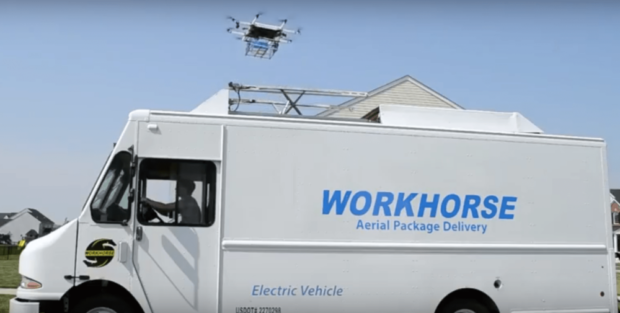Workhorse Group reported lower-than-expected revenue and another loss in the third quarter, this time blamed on California excluding its electric trucks from an incentive program. The Cincinnati-based company also may sell its drone business as it struggles to conserve cash it needs to scale the core medium-duty electric truck operation.
Drone Business May Be on the Block
Workhorse is conducting a strategic review of its drone business, originally envisioned as a truck-mounted application. Production of the HorseFly drone began in Mason, Ohio, during Q3. Efforts for Federal Aviation Administration certifications continue.
“Now [it] is prudent to ensure we are unlocking the most value for Workhorse shareholders, while best positioning our Aero business to capture and fund future growth opportunities,”
Workhorse CEO Rick Dauch said.
Workhorse spends about $700,000 a month on the drone business, CFO Bob Ginnan said. That money could be applied to the truck business.
By the Numbers
Workhorse recorded $3 million in Q3 sales, mostly from the reversal of a $2.4 million sales allowance for W4CC vehicles. That compared with $1.5 million in the same period last year.
Selling fewer vehicles reduced the cost of sales to $6.6 million compared to $9.5 million a year ago. Getting rid of C-Series vehicles the company recalled and bought back from customers reduced inventory reserves by $2.9 million.
The net loss for the third quarter of 2023 was $30.6 million compared to a net loss of $35.4 million a year ago.
Workhorse had about $38.9 million in cash at the end of Q3, down from about $62 million at the end of Q2. Inventory clearing reduced its quarter-over-quarter cash burn. The company is in advanced discussion to raise money for scaling. Workhorse burns through about $20 million a quarter.
Shareholders approved an increase in the authorized share count to 450 million shares from 200 million on Sept. 1. That allows the company to use new shares to back capital increases, but the low stock price makes that harder.
Revamped Product Lineup
Betting on the future has long been Workhorse’s way of operating. With a pending notice of going concern, a stock price unchanged at 40 cents on Tuesday and minimal cash, its future is anything but assured. Amid these challenges, Dauch has led a 22-month revamping of products to assure automotive-grade quality.
Step vans typically stay in fleets for 15-20 years. The introduction of electromobility raises durability questions despite promises of less maintenance and total cost of ownership far exceeding internal combustion engines.
Fleets Hesitate on Electric Truck Orders
The lack of vouchers — valued at $40,000 each — from the Hybrid and Zero-Emission Truck and Bus Voucher Program (HVIP) led potential customers to avoid placing orders for Workhorse’s Class 4-6 W4C cab chassis, and W750 and W56 step vans. The California Air Resources Board (CARB) last Wednesday cleared the way for Workhorse’s participation in HVIP.
“CARB established a first-of-its-kind program for intermediate vehicle manufacturers with Workhorse. As a result, we now have our own voucher pool here at Workhorse, a huge enabler for commercial EV sales,” Workhorse CEO Rick Dauch said on the company’s earnings call with analysts. “Without those incentives, you aren’t really going to sell too many trucks.”
“We are seeing some wariness on the part of the fleets. Are these EV trucks really going to be capable of handling the duty cycles and the payloads and the ranges that they require on a day-to-day basis?” Dauch asked.
A California Trucking Association challenge to the January 2024 implementation of the Advanced Clean Fleets rule also is causing some fleets to hold back on ordering the more expensive electric trucks until they must. The CTA challenge should be heard in the next 30-60 days, Dauch said.
“My experience growing up in the auto industry for almost 50 years now, I’ve seen CARB lose battles. But I’ve never seen CARB lose the long war,” Dauch said.
Source: Freight Waves

